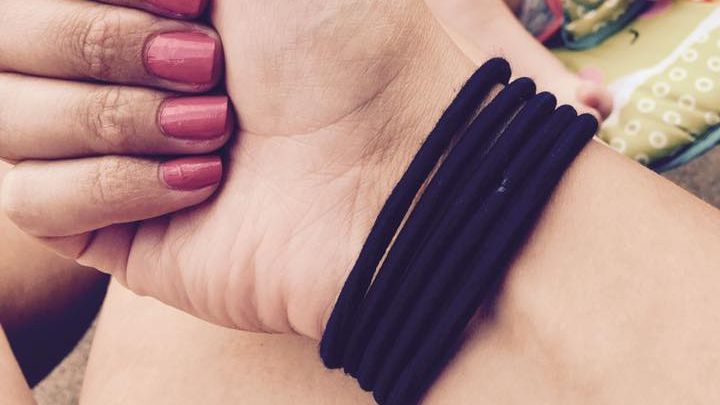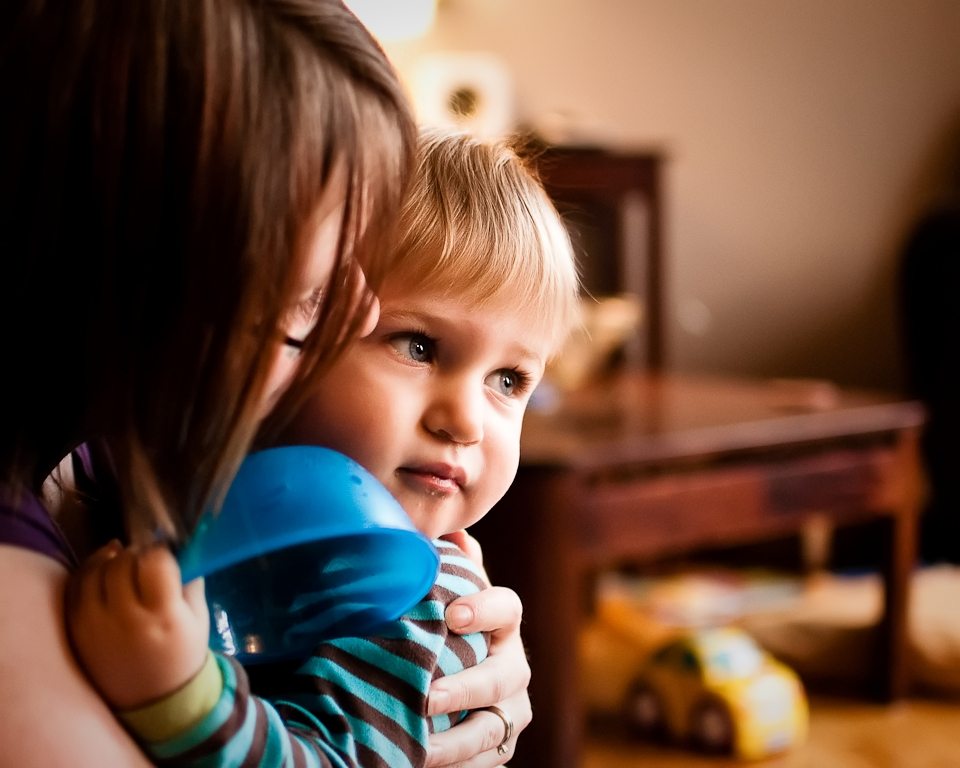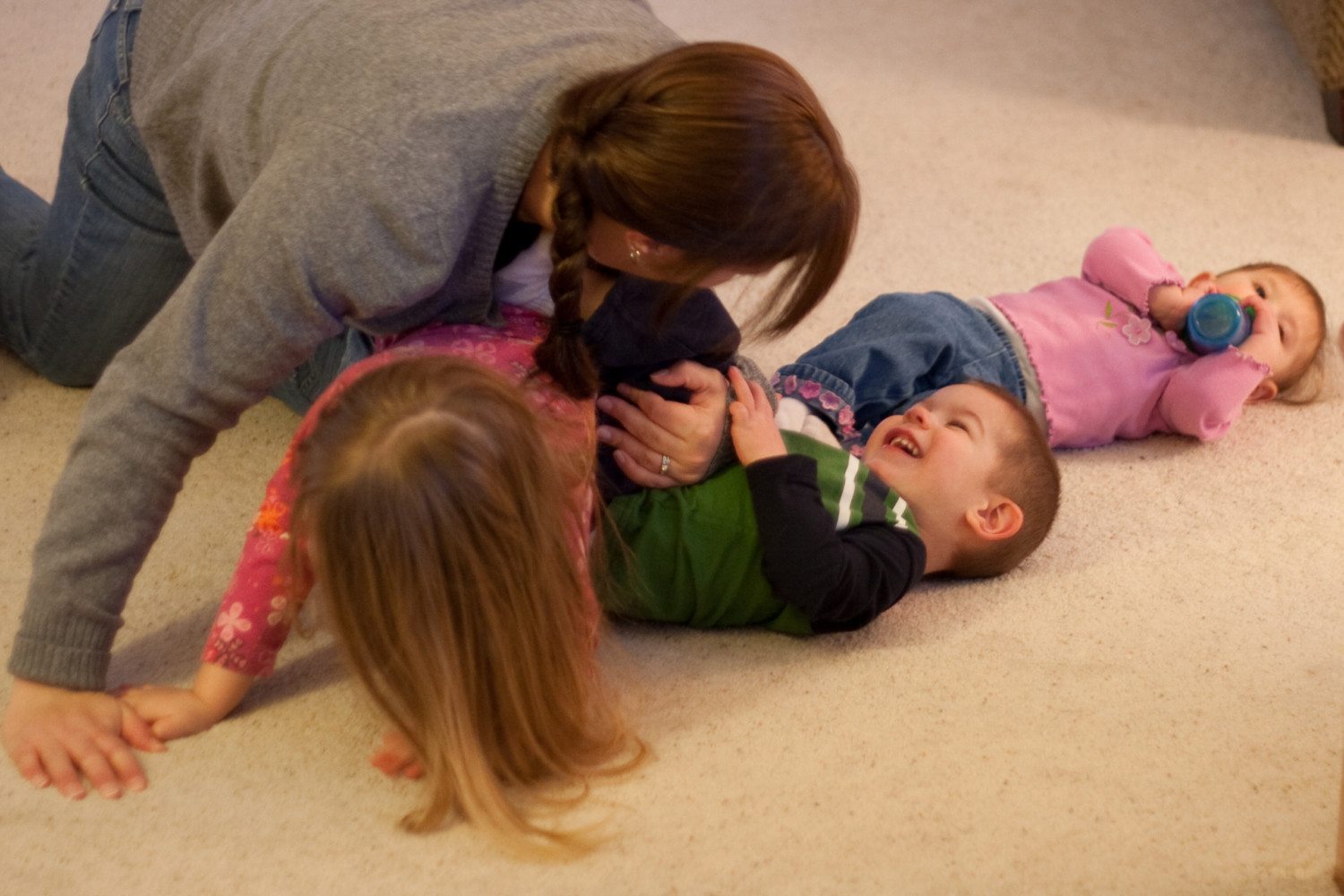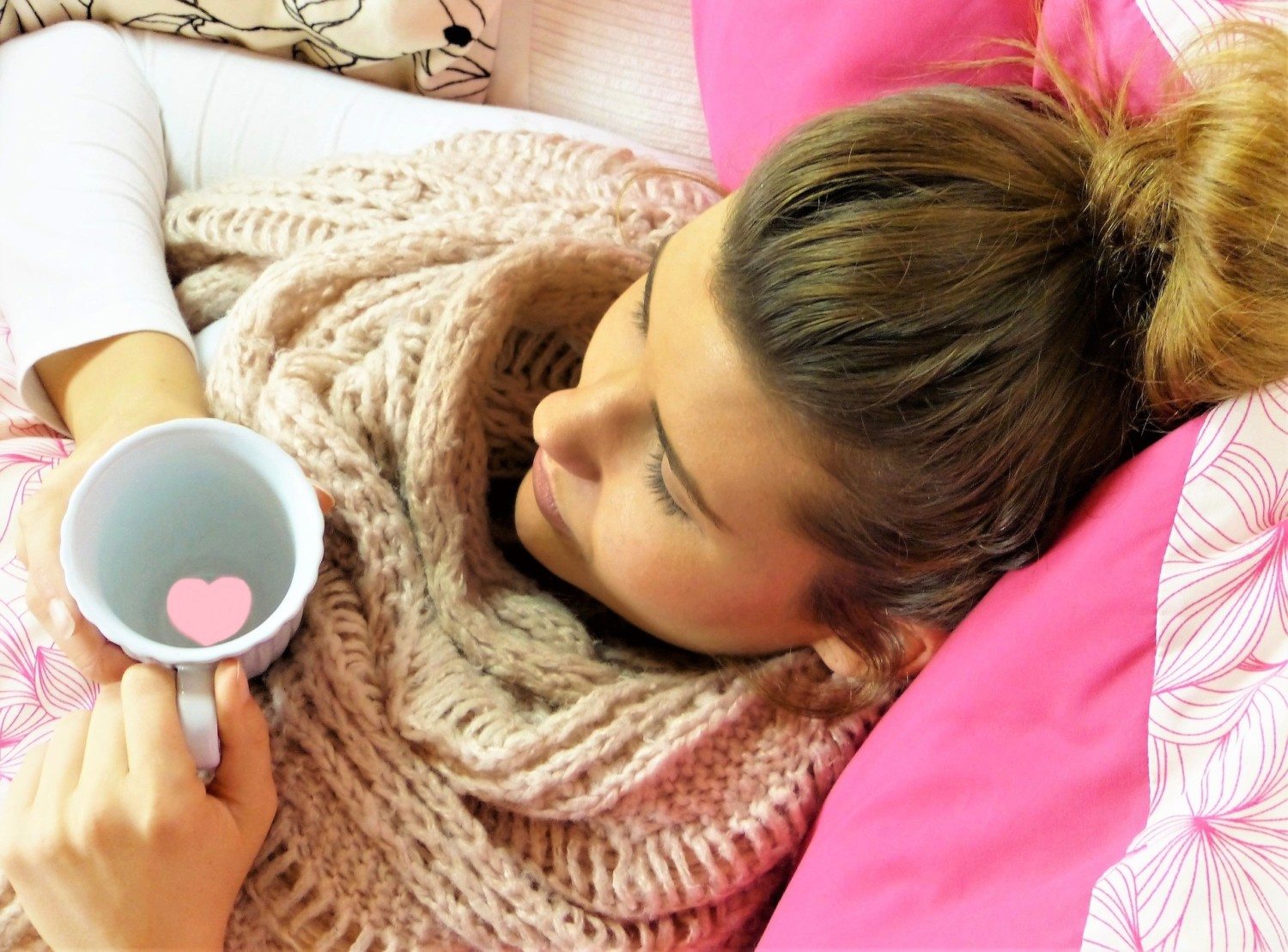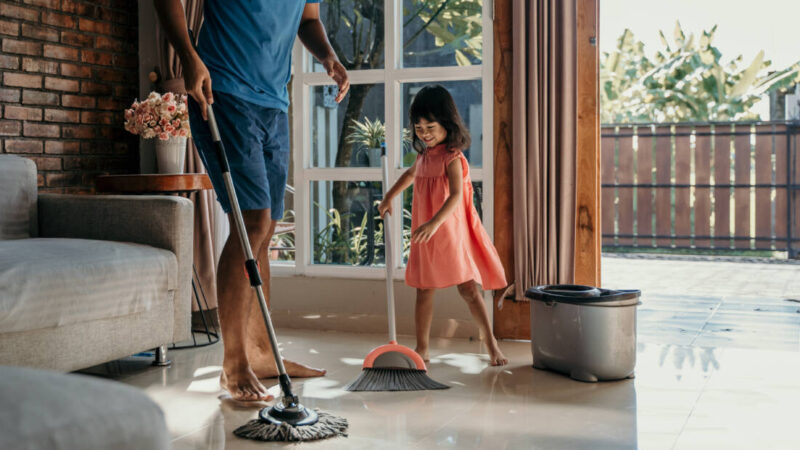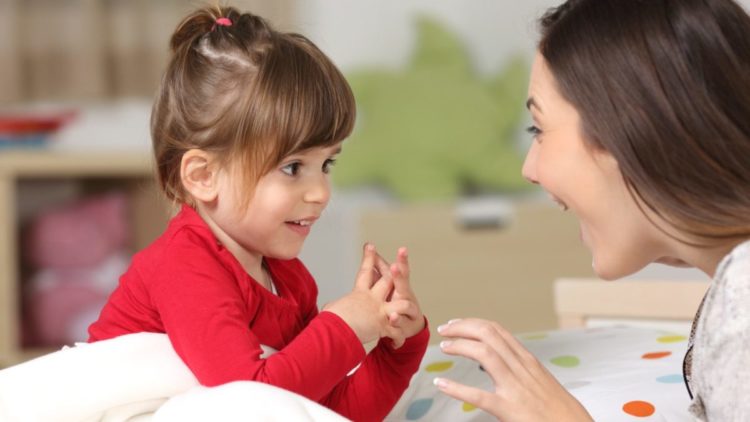What parenting experts have to say about this hair tie trick that has gone viral
In this clever blog post, a mom shared her tip for being consciously kinder to her kids, and it has gone viral. All it takes is a handful of those hair elastics virtually every mother has lying around the house.
Kelly Holmes first shared the tip on her blog, The (Reformed) Idealist Mom. After losing her cool with her preschooler during a particularly stressful moment (what parent hasn’t been there?), Holmes decided to unlearn the habit of speaking sharply to her child.
Changing Parenting Habits
She decided that visual cues would help remind her to avoid this unpleasant practice. Every morning, she places five hair ties on one of her wrists. Any time she snaps at one of her children, she moves a hair tie to the opposite wrist. The goal is to have all five bands on the original wrist at the end of the day.
Of course, no parent is perfect. Holmes’ approach lets her earn back moved hair ties with positive interactions. According to her research, it takes five positive interactions to negate each negative one.
According to Holmes, this method works wonders. Others seem to agree. Another mom by the name of Shauna Harvey shared her experience with this parenting hack.
“I have finished the day with all 5 bands on the original wrist. I’m very proud of myself for exercising patience with him [her 4-year-old son],” Harvey wrote in a Facebook post about her first day wearing the hair bands.
We decided to take it a step further and ask some experts for their insights and opinions on this parenting practice.
This Method Has Its Merits
“There are several things I like a lot about this technique,” says psychologist and author Eileen Kennedy-Moore, Ph.D. “It’s easy to use. It recognizes that anger and irritation with our children can be a habit. It encourages peaceful communication. It acknowledges that if we want our children to behave better, we have to put our calmest and kindest foot forward. It allows for imperfection and gives simple ways to get back on track rather than staying stuck feeling like a bad mom.”
Dr. Michelle Cutler, Associate Professor in the Clinical Psychology Doctoral Program at The Chicago School of Professional Psychology agrees.
“The best part of this approach is that it helps us as parents to be mindful about how we are responding to our children—both in the moment when we are frustrated, and intentionally, when we make efforts to reconnect and reassure them,” Cutler says.
“I think the author is right in recognizing the day-to-day stressors of parenting,” she continues. “And how some kids are more able to ‘push our buttons’ so that we lose our cool than others. On the basic level, this is a good way to change a behavior that has become a habit, just like a sticky note, mantra that we repeat to ourselves or any other visual reminder. The most important thing is recognizing when we lose our temper, and making an effort to change it.”
Dr. Eleazar Eusebio, Psy.D., NCSP, Chair of the School Psychology Department at the Chicago School of Professional Psychology in Washington, D.C. wasn’t sure the approach was useful at first blush.
“Upon first reading The Idealist Mom’s article, I thought the hair tie strategy seemed a bit unusual,” he admits. “However, considering it adopts noted psychologist John Gottman’s exploration of positive-to-negative ratios in marriages and his ‘magic ratio’ of 5:1 positive to negative interactions, there appears to be some benefits that could generalize over to parent-child relationships.”
“According to Nobel Prize winning psychologist Daniel Kahneman, we experience approximately 20,000 moments each day and the quality of our lives is determined by how our brains recognize and categorize our moments as either positive, negative or neutral,” Eusebio says. “The hair tie strategy can help a busy parent to monitor their positive and negative interactions with their children.”
“As a parent of two young boys,” Eusebio adds, “I know how difficult it can be to manage and track your behaviors, particularly while in the moment. However, a concrete strategy may serve to help a parent consciously engage and be present in their interactions.”
Improving Upon The Approach
The experts seem to agree that while the method is definitely a step in the right direction, parents may want to dig a little deeper.
RELATED: Forget Terrible Twos: Welcome To The Nightmare That Is Raising A 3-Year-Old
“What I think is missing from the strategy is the larger context,” notes Kennedy-Moore. “For example, if there are situations that are routinely difficult, it’s worth stepping back to think about how to make them easier. Kids often have good ideas about how to do this, and engaging them in problem-solving discussions is a great learning opportunity.”
Kennedy-Moore references one of the issues that Holmes mentions in her original article—shoes lying all over her home—as one where a parent could get the kids involved in problem solving.
“Mom could speak with the kids in a calm moment and say, ‘We have a problem: shoes left all over are dangerous because people could trip and fall on them. What could we do to solve this?’” she suggests. “A basket by the door, cubbies or official shoe collector roles are possibilities.”
Cutler says parents may also benefit from digging into the source of their own frustrations and tempers.
“I would also encourage any parent who finds themselves yelling then regretting it, saying things they don’t mean, or losing their temper, to think a little deeper about what it is that sets them off,” recommends Cutler. “Once the moment is over and they are in a calmer space, it’s worth exploring what went through their mind at that moment that got in the way of them being the calm and nurturing parent they want to be.”
Getting a hold on our own emotions is one way we can help our kids gain control over their own.
“Our kids need our help to learn to regulate their emotions,” she says, “and if we can’t do it for ourselves, this will be even more of a challenge for them to learn. And it is often the kids that have the most challenges with emotional regulation that we have the strongest reaction to!”
She advises that the first thing to do is determine the trigger that caused the unbecoming outburst.
“So what set us off? Were we stressed about something else? Feeling guilt or regret about an earlier interaction? Making assumptions about our children that we later see aren’t true? Or are these interactions bringing up memories of our own experiences of being parented, and we are reacting to that?” asks Cutler. “This may not always happen consciously, but often if we give ourselves the space and time to think about it, we can recognize patterns from our past. Sometimes, this realization can help us to see that there are things in our own history from which we still need to heal, so that they don’t affect our parenting. This is where therapy can be helpful.”
She proposes using the hair ties as prompts for self-care, as well.
“Another thing I would add to this technique is incorporating some sort of calming/regulating technique for ourselves,” advises Cutler. “Maybe having to move a hair tie means that we need a five-minute break by ourselves (this could be a good time to let the kids watch a TV show), or some deep breathing, or a quick text to a friend who can relate, whatever works to help us reset. Then we will be in a better place to help our kids do that!”
Eusebio wonders whether the science behind the approach, which was originally used with married couples, can also be applied to parents and children.
“Gottman and his colleagues observed 700 newlywed couples and predicted whether they would stay together or divorce by scoring and quantifying the number of positive and negative interactions they had with one another within a 15-minute conversation,” he explains. “Ten years later, the follow-up predictions were accurate 94 percent of the time.”
“Gottman’s findings and methodology may not generalize to the relationships of parents and young children,” Eusebio notes. “However, some projects have begun to look at behavioral parent training to explore whether participants can benefit from the magic ratio and the positive results seen in couples.”
Ultimately, he seems to be in favor of the method, with a few considerations.
RELATED: This Chart Shows You When You Should Put Your Kids To Bed
“As for the delivery of the hair tie strategy, any system that includes an additional visual component has both a positive and a negative implication,” says Eusebio. “On the negative side, others may question your fashion choices and new obsession with hair ties. In the case of The Idealist Mom’s article, the child may be sensitive to your methodology, which would need a conversation of what you are monitoring and why. The hope, I would think, is to get to the point where you wouldn’t have to use the hair ties at all (as she claimed). On the flip side, you may start a fashion trend.”
[h/t: Huffington Post]


